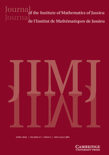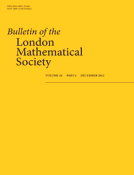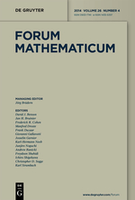
Pure and Applied Mathematics Quarterly
Scope & Guideline
Exploring the Depths of Theoretical and Practical Mathematics
Introduction
Aims and Scopes
- Geometric Analysis and Differential Geometry:
This area includes research on the geometry of manifolds, curvature properties, and the stability of geometric structures, often employing techniques from differential equations and topology. - Mathematical Physics:
Papers in this domain explore the mathematical foundations of physical theories, including general relativity, quantum mechanics, and the analysis of spacetimes, often utilizing advanced calculus and algebraic techniques. - Algebraic Geometry and Number Theory:
This scope covers the study of geometric structures over algebraic varieties, including cohomology theories, modular forms, and arithmetic properties, emphasizing the connections between geometry and number theory. - Functional Analysis and Operator Theory:
Research in this area focuses on the properties and applications of linear operators and functional spaces, addressing topics such as spectral theory and the analysis of differential operators. - Combinatorics and Graph Theory:
This field includes studies on graph properties, combinatorial structures, and their applications in various mathematical contexts, highlighting the role of discrete mathematics in broader mathematical theories. - Topology and Homotopy Theory:
Papers investigate topological spaces, continuous functions, and homotopical properties, contributing to the understanding of shape and space in mathematical contexts. - Mathematical Logic and Foundations:
This area explores the underlying logical structures of mathematics, including set theory, model theory, and proof theory, emphasizing foundational questions and their implications for mathematical practice.
Trending and Emerging
- Interdisciplinary Approaches:
There is a growing trend towards research that bridges pure mathematics with applied fields, particularly in areas like mathematical physics and data science, indicating a shift towards practical applications of theoretical concepts. - Nonlinear Dynamics and Stability Theory:
Recent publications increasingly focus on the stability of solutions to nonlinear equations, particularly in geometric contexts, underscoring the relevance of these studies in both mathematics and applied sciences. - Algebraic and Geometric Topology:
An emerging focus on algebraic invariants and their geometric interpretations is evident, reflecting a resurgence of interest in the connections between topology and algebraic structures. - Quantum Geometry and Mathematical Physics:
Research at the intersection of quantum theory and geometry is on the rise, highlighting the importance of mathematical frameworks in understanding physical phenomena.
Declining or Waning
- Classical Analysis Techniques:
While still relevant, traditional methods of analysis, such as those focusing exclusively on real and complex analysis without modern extensions, are less frequently discussed in recent publications. - Elementary Number Theory:
Papers solely dedicated to elementary aspects of number theory seem to have decreased, with more emphasis now placed on algebraic and geometric approaches to number-theoretic problems. - Discrete Mathematics without Applications:
Research focused purely on combinatorial aspects without practical applications or connections to other fields is becoming less common, indicating a trend towards interdisciplinary work.
Similar Journals

Journal of the Institute of Mathematics of Jussieu
Pioneering Research in the Heart of MathematicsJournal of the Institute of Mathematics of Jussieu, published by Cambridge University Press, is a leading academic journal that has established itself as a vital resource in the field of mathematics. With an impressive impact factor and a ranking in the top quartile (Q1) of miscellaneous mathematics, the journal serves as a platform for high-quality research from both established scholars and emerging researchers. Spanning from 2002 to 2024, the journal aims to foster collaboration and innovation in the mathematical community by publishing original research articles, reviews, and critical discussions on a wide range of mathematical topics. Although the journal does not offer open access, it remains widely accessible through various academic institutions and libraries, ensuring that critical advancements in mathematics are shared with a global audience. Located in the United Kingdom at the prestigious Cambridge campus, the journal reflects the rigorous standards of its publisher and the rich academic tradition of its home institution.

PUBLICATIONES MATHEMATICAE DEBRECEN
Exploring the Depths of Mathematical InquiryPublicationes Mathematicae Debrecen is a renowned international journal published by the University of Debrecen, Institute of Mathematics, situated in Hungary. This journal, with both ISSN 0033-3883 and E-ISSN 2064-2849, has established itself in the field of mathematics since its inception, with coverage extending from 1997 to 2024. Recognized for its rigorous academic standards, it currently holds a Q3 ranking in the mathematics (miscellaneous) category for 2023 and ranks at the 42nd percentile among general mathematics journals in Scopus. Publicationes Mathematicae Debrecen aims to disseminate high-quality research across various areas of mathematics, contributing to the advancement of knowledge and practice in this dynamic field. Although it is not an open-access journal, its readers can access a wealth of scholarly work that addresses both theoretical and applied mathematical issues, making it an invaluable resource for researchers, professionals, and students alike.

Cambridge Journal of Mathematics
Elevating Scholarship in the World of NumbersCambridge Journal of Mathematics, published by INT PRESS BOSTON, INC, is a premier platform for the dissemination of cutting-edge research in the field of mathematics. With an ISSN of 2168-0930 and E-ISSN 2168-0949, this journal stands out in a competitive academic landscape, currently ranked #58 out of 399 in General Mathematics, placing it in the top 15% within its category according to Scopus metrics. The journal serves as a vital resource for researchers, professionals, and students alike, aiming to foster groundbreaking mathematical inquiries and foster collaboration across disciplines. Published from 2020 to 2024, the Cambridge Journal of Mathematics is committed to maintaining high standards of scholarship, making it an essential read for those who are passionate about advancing mathematical knowledge and its applications.

MANUSCRIPTA MATHEMATICA
Advancing Mathematical Frontiers.MANUSCRIPTA MATHEMATICA is an esteemed journal in the field of mathematics, published by Springer Heidelberg. Since its inception in 1969, this journal has served as a pivotal platform for disseminating high-quality research in a variety of mathematical disciplines, with a commitment to advancing knowledge and fostering collaboration among mathematicians. The journal holds a commendable impact factor and is ranked within the Q2 category for Mathematics (miscellaneous) in 2023, placing it favorably among its peers in terms of academic influence. Although open access options are not available, its rigorous peer-review process ensures that published articles maintain the highest academic standards. With a wide scope covering significant areas of general mathematics, MANUSCRIPTA MATHEMATICA not only caters to researchers and professionals seeking innovative insights but also serves as a valuable resource for students eager to deepen their understanding of mathematical theories and applications. For those looking to contribute to or stay informed about advancements in this dynamic field, the journal remains a crucial resource for literature and discourse.

BULLETIN OF THE LONDON MATHEMATICAL SOCIETY
Connecting Scholars Through Mathematical ExcellenceThe BULLETIN OF THE LONDON MATHEMATICAL SOCIETY, published by Wiley, is a distinguished journal that serves as a vital resource in the field of mathematics. With its ISSN 0024-6093 and E-ISSN 1469-2120, this journal has consistently provided a platform for innovative research and scholarly discourse since its inception in 1969. Recognized for its quality, it currently holds an impressive Q1 ranking in the mathematics category, a testament to its significance in disseminating influential findings and trends in the mathematical sciences. Researchers and practitioners can rely on the BULLETIN for its comprehensive coverage of both theoretical and applied mathematics, which caters to a diverse audience ranging from professionals to students alike. Though it does not currently offer Open Access options, its articles can be accessed through institutional subscriptions, ensuring that significant works reach the academic community effectively. With contributions that span over five decades, the journal continues to shape mathematical research and inspire future advancements in the discipline.

FORUM MATHEMATICUM
Where Mathematics Comes to Life: A Forum for ScholarsFORUM MATHEMATICUM, published by WALTER DE GRUYTER GMBH, is a distinguished academic journal based in Germany, known for its significant contributions to the field of mathematics. With an ISSN of 0933-7741 and an E-ISSN of 1435-5337, the journal features comprehensive studies ranging from applied mathematics to diverse mathematical disciplines. Having maintained a commendable presence since 1989, FORUM MATHEMATICUM has achieved notable classification rankings, including Q2 in Applied Mathematics and Q1 in miscellaneous Mathematics as of 2023. Additionally, it holds a Scopus rank within the top 60th percentile in General Mathematics, making it a prominent platform for researchers and professionals seeking rigorous analysis and innovative methodologies in mathematics. While the journal does not currently offer open access, its rich content is pivotal for advancing mathematical theory and applications, appealing to students and seasoned academics alike.

INDIAN JOURNAL OF PURE & APPLIED MATHEMATICS
Pioneering Insights in Pure and Applied MathematicsINDIAN JOURNAL OF PURE & APPLIED MATHEMATICS, published by the INDIAN NATIONAL SCIENCE ACADEMY, stands as a vital resource in the realm of pure and applied mathematics since its inception in 1996. With ISSN 0019-5588 and E-ISSN 0975-7465, this journal aims to disseminate original research that advances the understanding and application of mathematical principles. Operating out of New Delhi, India, it serves a diverse readership comprising researchers, scholars, and practitioners in the mathematical sciences. Recognized within the Q3 category in both Applied Mathematics and Miscellaneous Mathematics as per the 2023 category quartiles, the journal emphasizes rigorous peer-reviewed articles that contribute to its impact in academia, reflected in its Scopus rankings. Although it does not currently operate as an open-access journal, it maintains a commitment to quality and accessibility of scholarly content, striving to foster academic collaboration and innovation. The convergence of full-text issues from 1996 to 2024 highlights its ongoing dedication to the evolution of mathematical research.

TRANSACTIONS OF THE AMERICAN MATHEMATICAL SOCIETY
Pioneering Research in Applied and Theoretical MathematicsTRANSACTIONS OF THE AMERICAN MATHEMATICAL SOCIETY, published by the American Mathematical Society, is a premier journal in the field of mathematics that has been contributing to the advancement of mathematical knowledge since 1900. With an ISSN of 0002-9947 and an E-ISSN of 1088-6850, this journal holds a prestigious position in the academic landscape, evidenced by its Q1 rankings in both Applied Mathematics and Miscellaneous Mathematics categories as of 2023. With a Scopus ranking of #97 in General Mathematics and a percentile standing of 75th, the journal is recognized for its rigorous peer-review process and the quality of the research it publishes. Though it does not currently offer open access options, it essentially serves as a vital resource for researchers, professionals, and students seeking critical insights and developments in mathematical theory and applications. The Transactions aim to publish high-quality research articles that foster the exchange and dissemination of ideas, supporting the growth of both theoretical and applied mathematics within the global scholarly community.

Rendiconti del Circolo Matematico di Palermo
Advancing Knowledge in the Heart of Mathematics.Rendiconti del Circolo Matematico di Palermo, published by SPRINGER-VERLAG ITALIA SRL, is a revered journal in the field of mathematics, emphasizing the cultivation and dissemination of mathematical knowledge since its inception in 1887. With its ISSN 0009-725X and E-ISSN 1973-4409, this esteemed publication has continued to thrive, showcasing innovative research, comprehensive reviews, and thoughtful discussions from diverse areas in mathematics, particularly in its Q2 ranking within the miscellaneous mathematics category. Its historical significance is underscored by its convergence of publications across numerous years, including its notable periods from 1887 to 1916, 1919 to 1938, and beyond, effectively capturing the evolution of mathematical thought. Though not open access, the journal remains an essential resource for researchers, professionals, and students aiming to stay updated with the latest advancements and methodologies in the ever-evolving landscape of mathematics. With its Scopus rank placing it in the top 25th percentile, Rendiconti del Circolo Matematico di Palermo continues to be a cornerstone for scholarly dialogue and development in its domain.

Matematicki Vesnik
Championing high-quality research in the mathematical community.Matematicki Vesnik is a distinguished open-access journal published by the MATH SOC SERBIA-DRUSTVO MATEMATICARA SRBIJE, dedicated to advancing the field of mathematics since its inception. With an ISSN of 0025-5165 and an E-ISSN of 2406-0682, this journal has been a significant platform for disseminating research findings since its establishment in 1993. Hosted in Serbia, it embraces a broad scope of mathematical discourse while achieving a Q3 category ranking in miscellaneous mathematics for 2023. As part of its commitment to fostering scholarly communication, Matematicki Vesnik is accessible to a global audience, promoting high-quality research and innovative ideas within the mathematical community. With converged years from 1999 to 2024 and a Scopus rank of #232 out of 399 in General Mathematics, the journal plays a crucial role in enhancing visibility and impact for researchers, professionals, and students alike in the dynamic landscape of mathematical inquiry.